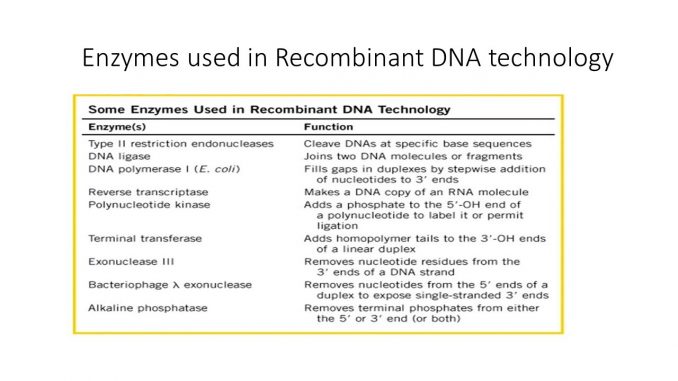
Enzymes used in recombinant DNA technology
- DNA ligase
- Reverse transcriptase
- Restriction endonuclease
- Terminal transcriptase
- Nuclease
- DNA polymease
- Ribonuclease-H
- Alkaline phosphatase
- Polynucleotide kinase
1. DNA ligase:
- DNA ligase is isolated from E.coli and Bacteriophage commercially and used in recombinant DNA technology.
- The enzyme DNA ligase joins the DNA fragments with cloning vector.
2. Reverse transcriptase:
- RT is used to synthesize complementary strand (cDNA) from mRNA template.
- It is also known as RNA dependent DNA polymerase
- It is isolated from retrovirus
3. Restriction endonuclease:
- Restriction endonuclease enzyme recognize and cut DNA strand at specific sequence called restriction site.
- These enzyme is isolated from wide variety of microorganisms. Endonuclease enzyme degrades foreign genome when enter inside microbial cell but the host cell own DNA is protected from its endonuclease by methylation of bases at restriction site.
- There are 3 types of restriction endonuclease:
Type I Restriction endonuclease:
- It has both methylation and endonuclease activity.
- It require ATP to cut the DNA
- It cuts DNA about 1000bp away from its restriction site
- eg. EcoKI
Type II Restriction endonuclease:
- It does not require ATP to cut DNA
- It cuts DNA at restriction site itself
- eg. EcoRI, Hind III
Type III Restriction endonuclease:
- It requires ATP to cut DNA
- It cuts DNA about 25bp away from restriction site.
- eg. EcoPI
4. Terminal transferase:
- It is the enzyme that converts blunt end of DNA fragments into sticky end.
- If the restriction enzyme cuts DNA forming blunt ends, then efficiency of ligation is very low. So the enzyme terminal transferase converts bunt end into sticky end.
- Terminal transferase enzyme synthesize short sequence of complementary nucleotide at free ends of DNA, so that blunt end is converted into sticky end.
5. Nuclease:
- The enzyme nucleases hydrolyses the phosphodiester bond on DNA strand creating 3’-OH group and 5’-P group.
- It usually cut DNA on either side of distortion caused by thymine dimers or intercalating agents
- The gap is filled by DNA polymerase and strand is joined by DNA ligase
- Nucelase are of two types; endonuclease and exonuclease
6. DNA polymerase:
- DNA polymerase is a complex enzyme which synthesize nucleotide complementary to template strand.
- It adds nucleotide to free 3′ OH end and help in elongation of strand
- It also helps to fill gap in double stranded DNA.
- DNA polymerase-I isolated from E. coli is commonly used in gene cloning
- Taq polymerase isolated from Thermus aquaticus is used in PCR
7. Ribonuclease-H (RNase H):
- RNase-H removes mRNA from DNA-RNA heteroduplex and that mRNA is used to synthesize cDNA
- It is isolated from retrovirus
8. Alkaline phosphatase:
- The enzyme Alkaline phosphatase helps in removal of terminal phosphate group from 5′ end
- It prevents self annealing of vector DNA soon after cut open by restriction endonuclease
9. Polynucleotide kinase:
- It adds phosphate group from ATP molecule to terminal 5’end after dephosphorylation by alkaline phosphatase.
